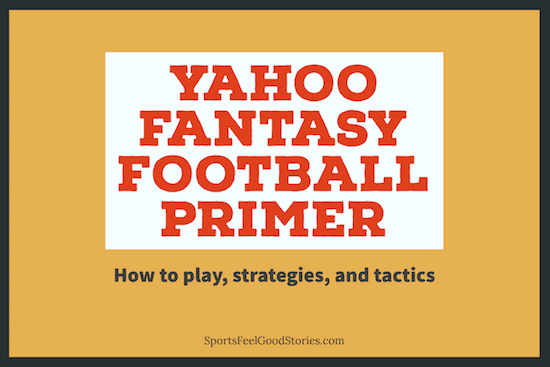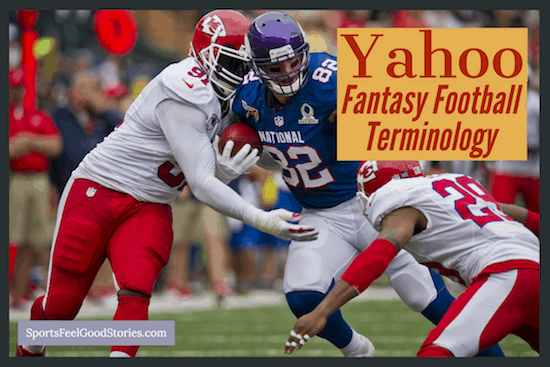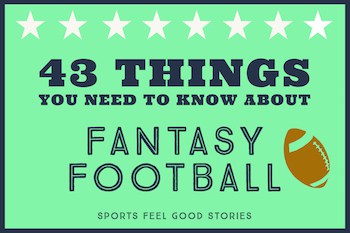Although there are many different platforms available to host your league, Yahoo Fantasy Football is widely considered one of the best options for fans looking to get the most out of their experience. It’s a season-long virtual game to draft your team – mimicking the NFL draft with draft picks to fill out your team roster – and manage your roster while putting up more victories than your competitor. The ultimate goal: win your league’s Super Bowl.
This article will go over some of the reasons why Yahoo is the superior choice, address how to get started and play, supply a glossary, and introduce some strategies to give you an excellent chance to win.
Benefits of Yahoo Fantasy Football Platform
1.) First and foremost: The Yahoo platform is free to use.
2.) Not only is it free, but it is also customizable, extremely reliable, easy to navigate, updates are fast and automatic, and the interface is well organized and simple.
3.) Furthermore, Yahoo goes above and beyond at making the experience fun and informative, with a post-draft recap and drafting grades for every team in the league as well as weekly recaps for all the matches and trophies for top performances in a variety of categories.
4.) Yahoo has been doing fantasy football for years and was a major player in bringing free fantasy football to the mainstream. Their easily customizable settings make Yahoo a perfect fit for the vast majority of fantasy managers. Game time scores update automatically in real-time and you can follow along and manage your team through the Yahoo Sports app by the fantasy sports leaders.
So you want to play fantasy football–now what? Well, there are two ways.

Join a Fantasy Football League
First, you can join a league. There are so many people playing fantasy football now that the best way to find a league is to do it the old fashioned way: ask your friends, family, and co-workers. Find out what leagues they are playing in and if they have room for you to join. (Chances are they’ll be in a Yahoo league or an ESPN league).
Most leagues have anywhere from 8 to 14 teams competing in them, with most people agreeing that 10 to 12-team leagues are the sweet spot.
Things to consider when joining a league
1.) What, if any, is the entrance fee? What are the prizes/ payouts?
2.) How many teams are in the league?
3.) Is it PPR (point-per-reception) or Standard scoring?
4.) Is it a Drafting league or an Auction league?
5.) Is it a Keeper league?
(If you are wondering what some of those terms mean, have no fear they’ll be explained in a moment.)
Create a Fantasy Football league of your own
If this is your first time playing fantasy football I highly recommend joining an existing league before making your own league so that you can get the hang of it first. But if you can’t find a league to join or if the leagues available really aren’t a good fit for you, making your own league is always an option.
Granted, there is a lot of responsibility that comes with running a league (known as being the league commissioner) but because Yahoo is so user-friendly, setting up and running a league isn’t nearly as daunting as it may sound!
First things first, ask around for anyone interested in playing fantasy. Start with friends, family, and coworkers, keep the buy-in low (or no buy-in at all) and shoot for getting at least 8 people for the league.
League size considerations
1.) An 8-team league is the minimum number of participants you will want. Anything less just isn’t as fun.
2.) 14-team league is the maximum number of participants you will want. Anything more and there won’t be enough star-power to fully round out the teams.
There is truly only one large, looming burden hanging over a fantasy league commissioner: setting a date for the draft.
Chances are you will need to get some ballpark dates/times that work for people and find the one that works best for everyone. The draft is the single most important event of the fantasy season and also a lot of fun, so you (and everyone else) will want to be present for it. Most drafts take place circa Labor Day. Auto-drafting is always a backup option but it isn’t as good as choosing the players you want and like.
Fantasy Football Glossary

In order to play fantasy football, you will want to learn the language and norms of the game. It will help everything go a little smoother and make it a little more fun.
Who’s who in fantasy football?
Commissioner: Runs the league.
Manager/Owner: Manages a team. Some leagues allow co-managers or co-owners. These are your league mates.
Roster: The players owned on each team.
Your “Line-up”: The (usually 9) players that you are going to start for the week’s match.
Bench: The players that are owned but will not be in any line-up for the week’s matches.
Free Agents: Players not owned on any fantasy team.
Hall of Fame Fantasy Football Team Names Video
The Fantasy Football Positions
Quarterback (Q): Most leagues will have one Q spot in the line-up
Wide Receiver (WR): Most leagues will have (2) spots: WR1 and WR2.
Running Back (RB): Most leagues will have (2) spots: RB1 and RB2.
Tight End (TE): Most leagues will have one TE spot for the line-up.
FLEX: A FLEX spot is a flexible position that can be played by any WR/RB/TE that isn’t already in your line-up. Most leagues will have one FLEX spot.
Kicker (K): Most leagues will have one K spot in the line-up.
Defense (D): Most leagues will have one D spot in the line-up.
Player Status Designations
A little letter next to a player’s name is never a good thing. In the event of this, you will want to read the player update provided automatically by Yahoo. Yahoo does a great job of explaining why the player’s status has changed as well as giving some advice about what to do.
If you have a player with a concerning status in your line-up, always remember to check back to see if he will be able to suit up for the game. Consider who you will set as the replacement player.
Questionable (Q) *: The player is questionable – may or may not be ready – to be able to play this week.
Doubtful (D): It doesn’t look good. The player is doubtful, or unlikely, to play.
Out (O): The player is out for the week. Make adjustments accordingly.
Physically unable to perform (PUP): The player is going to be out for some time.
Suspended (SUS): A suspended player, who usually has a come-back date listed.
Injured Reserve (IR): An IR player is usually done for the year.
(*) The Questionable designation is the most difficult one for managers. It means the player could play, or could not play, and may not know until a few days or a few hours before the game. And even then if the player does play, will he be at 100%? Will he have a significantly reduced roll? All of these are important things to consider when the inevitable “Q” pops up next to your players.
Fantasy Football Scoring
Standard Scoring
Standard scoring used to be the dominant scoring method for most fantasy leagues but has been slowly becoming less prevalent. In a standard scoring league, it doesn’t matter how many touches/catches a player gets; the stats that matter are yards and touchdowns.
A touchdown is worth 6 points. 10 yards gained is worth 1 point. Losing a fumble is -2 points. (Running Backs are the most vital position in standard-scoring leagues)
Point Per Reception (PPR)
The increasingly more popular scoring method. PPR awards 1 point for every catch made by an offensive player. In this scoring system, a player is awarded for usage, not just production: PPR is the exact same scoring as in a standard, with the addition of a point for every reception.
Wide receivers are the most vital position in PPR leagues, but running backs that frequently catch the ball out of the backfield are extremely valuable as well.
Quarterbacks, Defense, and Kickers each have unique methods of scoring but are arguably not as crucial as the WR/RB/TE/FLEX players, which make up 6/9 of your line up.
Decimal Scoring
Rather than keeping scores as whole numbers, decimal scoring aggregates all the stats of each player and awards fractional points for production. An example is: if your running back runs for 59 yards total in a game, you will be awarded 5.9 points.
In non-decimal scoring formats, 59 yards translates to only 5 points. Decimal scoring is preferred by many because it keeps the scores truer to the production and limits the likelihood of a tie game.
Assembling Your Team – The Draft
Do your homework. Yahoo analysts provide great resources for prepping for your draft or auction. There are mock draft results, rankings, position-specific tiers, and in-depth analysis for both PPR and Standard leagues.
Most leagues will do a draft. A common adage is: “You can’t win the championship on draft day,” but it is the single most important event to set yourself up for fantasy success.
Get Smart On Your Player Knowledge
Do some research prior to your draft day. Red Zone Rick has broken down each division with the top players identified by team and position. His expert analysis can make the difference between a so-so draft and a winning hand. Here’s an example breakout for the NFC North.
Snake Draft
The most widespread drafting method is a snake-draft. This means that the manager who drafts first in the first round drafts last in the second round, and so on.
In a draft, you will be “on the clock” when it is your turn to select a player. This means you will have anywhere from 45 seconds to a minute-and-a-half (depending on how the commissioner sets the draft) to make each selection.
Fantasy Football Draft Strategies: Tips for Winning
1.) Load up with running backs and wide receivers in the first few rounds of the draft. If that flashy quarterback is there early in the draft, exercise your restraint and wait a little bit longer.
2.) Instead, select quarterbacks in the mid-rounds can often have the greatest return on investment.
3.) And don’t even think about taking a kicker or defense until at least the double-digit rounds.
4.) You can also set you “queue” for players you are interested in drafting. This is a very useful feature because you can stay organized with which players you are still targeting. And it is even more useful in the event that you need to step away from the draft for a few moments because you can set your selection process to “auto-select”, which will automatically draft from your top-desired players in the queue.
Auction For Player Selection
Auctions tend to be for more advanced leagues. This isn’t a universal truth, but for the most part, I recommend staying away from auctions especially if you are new to fantasy football. All things considered, the auction process is very efficient but it can take much longer than a draft.
The auction works exactly as you think it would. Each team has a set budget, and managers bid on players. Only one player can be bid on at a time. If you are doing an auction, avoid spending big on a top player.
The risk-reward factor is disproportionate. Instead, spend on some mid-range players and save most of your money for the end of the draft. There will be excellent value here, and if you did your budgeting right you will make off with some steals.
Keeper Leagues and Auctions
The only caveat here is if you are playing in a Keeper League. A Keeper League is a league that has managers returning every year – and they tend to be extremely competitive.
In a keeper league, the ideology for success is slightly shifted because managers are able to claim a small selection of top-players from last season to automatically return to their teams for the upcoming season.
Spending big on a top player in an auction can make a lot more sense if you expect years of heavy production.
After The Team Selection: Now What?
One word: Waivers. The waivers are the trenches of fantasy football. Every week there will be a new period for waivers where managers can make their bids at the unowned free agent pool.
There are three primary ways that leagues will set up their waivers. No one is necessarily better than any other, but it is important to check what method your commissioner has chosen so that you know what to expect when the time comes.
Types of Waivers (#1): Weekly Reset
The first way is weekly reset, inverse standings. That means that the team ranked last each week gets to select the first free agent off of waivers. The team ranked first selects last. This method is aimed at balancing out the league over the course of the season.
Types of Waivers (#2): Rolling Waivers
Next is the rolling waiver position. This starts with the team that initially selected last in the first round of the draft being able to select first in waivers. The rolling aspect of this waiver process means that if the manager with the top waiver selection decides not to issue a claim that week, the top selection rolls-over to the next week and so on until the manager uses the pick. Spending your pick moves you to the back of the line.
Saving the top pick until a dynamite player shows up on waivers can be an excellent strategy.
Types of Waivers (#3): Free Agent Acquisition Budget (FAAB)
Finally, we have the FAAB waiver method. FAAB stands for Free Agent Acquisition Budget. This is like a silent auction: each manager gets a set budget for the season and places a bid each week on the desired players. When the budget is spent, it is tough sailing for the rest of the season.
Please note that FAAB is commonly used in auction leagues.
Once the waiver process has concluded, any remaining free agents can be picked up freely first-come, first-served.
The Regular Season
The regular Yahoo Fantasy Football season typically is 13 games long. During the season, you can propose trades with other managers. There is usually a trade deadline set by the commissioner, however, so be aware of when your last chance to make a trade is.
Yahoo Fantasy Football Playoffs
The playoffs are usually weeks 14, 15, and 16. Week 17 typically isn’t included because it is the final week of the NFL regular season and too often NFL teams will rest their starters that week, which makes Week 17 not a good fit for the fantasy football championship.
Parting Tips For a Fun Yahoo Fantasy Football Season
That’s about all you need to know to get your foot in the Fantasy Football door.
When you join a league, go into the league details and read over the scoring, the trade deadline, waivers, and any other details that might be specific to your league. Ask questions of your league mates in the message boards.
Think up a clever or witty fantasy football team name and maybe even stir the pot with a little trash talk if you’re feeling spicy. It’s never too early to start getting in your opponents’ heads – it’s sports after all.
Yahoo’s Fantasy Sports app is something you will want to download if you have a smartphone. The mobile app if fully encompassing of the fantasy platform and gives you the freedom and convenience to check and update your team from just about anywhere. It now has a dark mode to save your smartphone some juice.
Have fun, good luck, and may the fantasy gods smile upon you.
— Red Zone Rick
Rick covers fantasy football and the NFL for Sports Feel Good Stories.
Extra Points
You’re on Yahoo Fantasy Football Primer page.
You might like:


